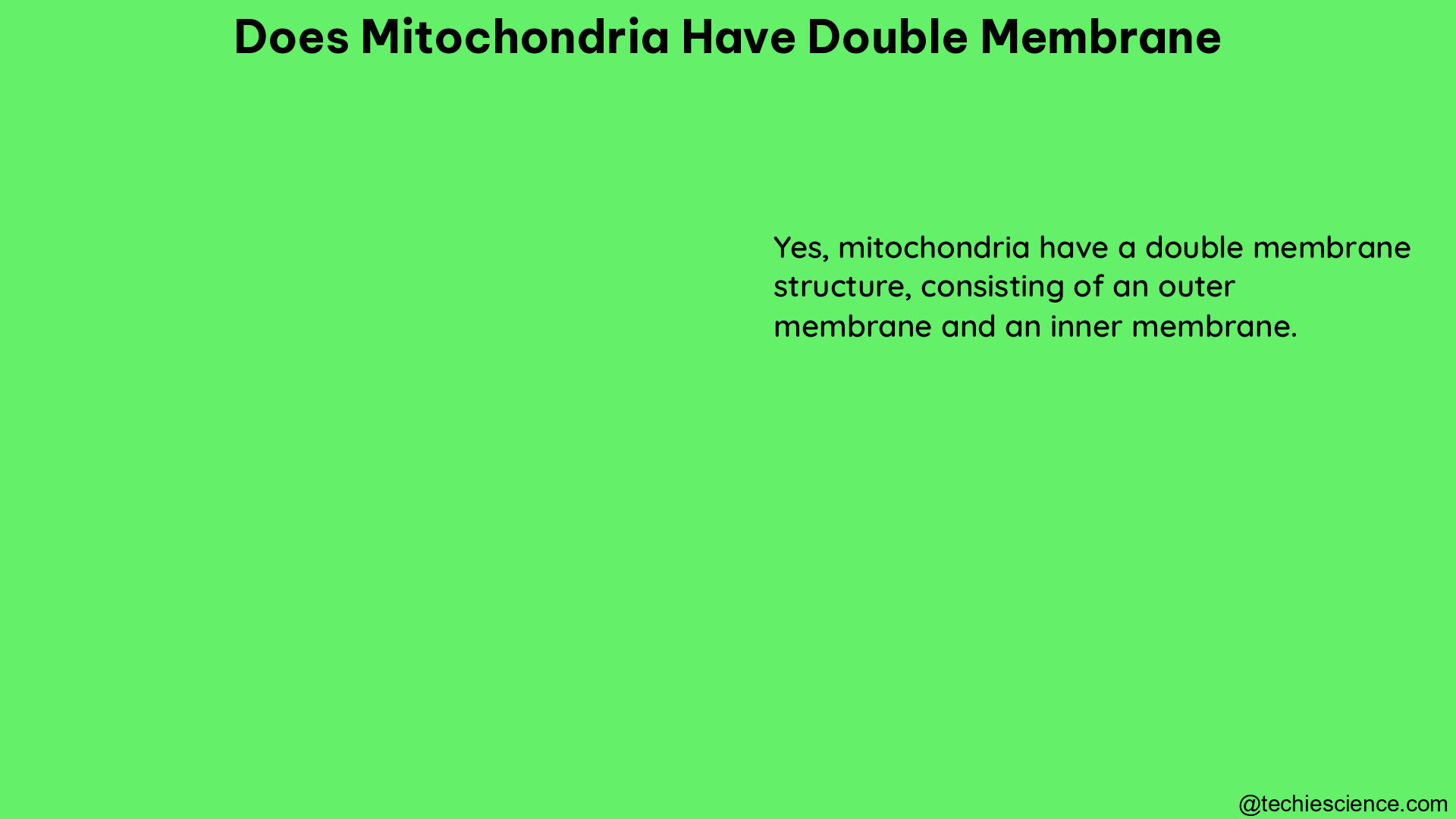Mitochondria, often referred to as the “powerhouses” of eukaryotic cells, are organelles that play a crucial role in cellular energy production. A defining characteristic of these organelles is their unique double-membrane structure, which is essential for their function. This comprehensive guide will delve into the intricate details of the mitochondrial double membrane, its significance, and the underlying mechanisms that make it a vital component of these cellular powerhouses.
The Outer Mitochondrial Membrane
The outer mitochondrial membrane is the outermost layer that fully surrounds the inner membrane. This membrane is relatively permeable, allowing the passage of small molecules and ions through protein-based pores known as porins. These pores have a diameter of approximately 2-3 nanometers (nm), which permits the diffusion of molecules up to around 5,000 Daltons in size, including metabolites, ions, and small proteins.
The outer membrane is composed of a phospholipid bilayer, similar to the plasma membrane of the cell, but it has a higher proportion of the phospholipid cardiolipin. Cardiolipin is a unique phospholipid found primarily in the inner mitochondrial membrane and plays a crucial role in the organization and function of the electron transport chain.
The Intermembrane Space

Between the outer and inner mitochondrial membranes lies a narrow space called the intermembrane space. This space is crucial for the generation of the proton gradient, which is the driving force behind the synthesis of adenosine triphosphate (ATP), the primary energy currency of the cell.
The intermembrane space is relatively small, typically measuring only 10-20 nanometers (nm) in width. Despite its small size, this space plays a vital role in the compartmentalization of various biochemical processes within the mitochondria.
The Inner Mitochondrial Membrane
The inner mitochondrial membrane is the innermost layer of the organelle and is responsible for the majority of the mitochondria’s functions. This membrane is highly specialized and has a much lower permeability compared to the outer membrane, resembling the plasma membrane of prokaryotic cells.
The inner membrane is densely packed with a variety of proteins, including those involved in the electron transport chain, ATP synthase, and the transport of metabolites and ions. This high protein content, along with the unique lipid composition, gives the inner membrane a characteristic folded structure known as cristae.
The cristae increase the surface area of the inner membrane, allowing for a more efficient organization and operation of the electron transport chain and ATP synthase. The inner membrane is also the site of the mitochondrial genome, which contains a small circular DNA molecule encoding a limited number of genes.
Mitochondrial Genome and Protein Synthesis
Mitochondria possess their own circular, double-stranded DNA (mtDNA) molecule, which is distinct from the nuclear DNA of the host cell. This mitochondrial genome is much smaller than the nuclear genome, typically ranging from 16 to 17 kilobases (kb) in size.
The mitochondrial genome encodes a small number of genes, primarily those involved in the electron transport chain and ATP synthesis. These genes include subunits of the respiratory complexes, ribosomal RNAs (rRNAs), and transfer RNAs (tRNAs) necessary for the translation of mitochondrial-encoded proteins.
Mitochondria also have their own protein synthesis machinery, including ribosomes and the necessary enzymes for transcription and translation. This allows them to synthesize a few of their own proteins, although the vast majority of mitochondrial proteins are encoded in the nuclear genome and imported into the organelle.
The Proton Gradient and ATP Synthesis
The double-membrane structure of mitochondria is crucial for the generation of the proton gradient, which is the driving force behind the synthesis of ATP, the primary energy currency of the cell.
During the process of oxidative phosphorylation, the electron transport chain located in the inner mitochondrial membrane pumps protons (H+ ions) from the matrix (the space within the inner membrane) to the intermembrane space. This creates a proton concentration gradient, with a higher concentration of protons in the intermembrane space compared to the matrix.
The proton gradient, or proton-motive force, is then used by the enzyme ATP synthase to drive the synthesis of ATP. ATP synthase is also located in the inner mitochondrial membrane and uses the energy stored in the proton gradient to phosphorylate adenosine diphosphate (ADP) to produce ATP.
Evolutionary Significance of the Mitochondrial Double Membrane
The double-membrane structure of mitochondria is believed to have evolved from a symbiotic relationship between an ancient prokaryotic organism and a primitive eukaryotic cell. The prevailing theory, known as the endosymbiotic theory, suggests that mitochondria originated from a free-living, oxygen-respiring prokaryote that was engulfed by a primitive eukaryotic cell.
Over time, the engulfed prokaryote evolved to become an integral part of the eukaryotic cell, providing a more efficient means of energy production through oxidative phosphorylation. The double-membrane structure of mitochondria is thought to be a remnant of this ancient symbiotic relationship, with the outer membrane representing the former plasma membrane of the prokaryotic ancestor and the inner membrane representing the former cytoplasmic membrane.
Conclusion
The double-membrane structure of mitochondria is a defining characteristic of these organelles and is essential for their function as the powerhouses of eukaryotic cells. The outer membrane, the intermembrane space, and the highly specialized inner membrane work together to create a compartmentalized environment that enables the efficient generation of ATP through oxidative phosphorylation.
This intricate structure, along with the mitochondrial genome and protein synthesis machinery, is a testament to the evolutionary history of these organelles and their crucial role in cellular energy metabolism. Understanding the details of the mitochondrial double membrane is not only fascinating from a biological perspective but also crucial for understanding various cellular processes and their implications in human health and disease.
References:
– Mitochondrial Structure and Function
– Why Do Mitochondria Have Two Membranes?
– Do Mitochondria Have a Double Membrane?
– Mitochondria

Hello, I am Bhairavi Rathod, I have completed my Master’s in Biotechnology and qualified ICAR NET 2021 in Agricultural Biotechnology. My area of specialization is Integrated Biotechnology. I have the experience to teach and write very complex things in a simple way for learners.